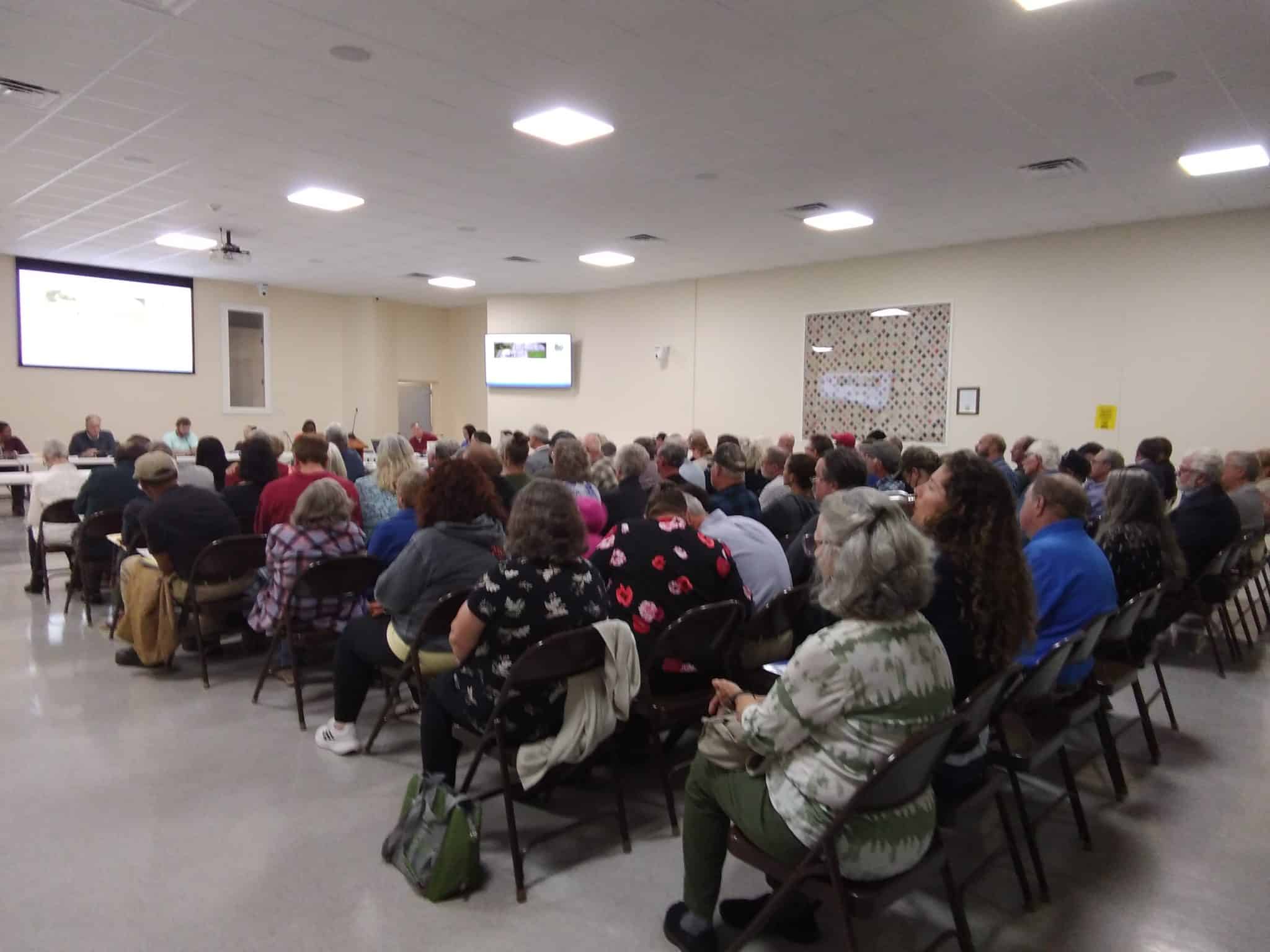Residents of southeastern Person County, NC came to the Person County Office Building auditorium for the November 9 meeting of the Person County Planning Board to voice their concerns about Dominion Energy’s proposed Moriah Energy Center. Dominion came before the board seeking to rezone a 485 acre parcel of land from “rural”, to “industrial”. The proposed facility would initially include one 25 million gallon liquified natural gas storage tank, but plans submitted by Dominion suggest that a second tank could be built there in the future.
More than 100 people attended the Thursday evening meeting. Prior to the start of a public hearing on the matter, Planning Board Chairman, Barry Walker, announced that 25 people had signed up to speak.

Of the 25 people who signed up to speak during the hearing, only two speakers spoke in support of approving the rezoning proposal. The overwhelming majority of those who spoke live within 2 miles of the proposed site. Eighty-four year old Lois Brown, who lives about 500 feet from the proposed site of the facility, was the first speaker of the night. Brown, who lives alone, said she was “terrified” when she learned of the project, noting the certainty of noise and light pollution, as well as the potential for accidents.
Several speakers expressed concerns about the speed at which the process has moved, and the fact that many of those who live closest to the site of the proposed rezoning were only made aware of the project through word of mouth and the newspaper. “I live about 1.8 miles away from the proposed site” said Michael Savino. “I just want you to know that I learned about this by reading the paper, and it sounded like a done deal. I felt kind of stabbed in the back by whoever did these negotiations because they left us out of the process.” Don Ahrens, who lives less than 2 miles from the site, said “I read today in the paper that the Economic Development Commission had been in negotiations [with Dominion] for 18 months. I learned about this on October 30.”
Others who spoke expressed concerns about safety, protecting the environment and endangered species, property values, and the uncertainty involved with rezoning a wooded rural residential area for heavy industrial use. Ronnie Reaves, said he recently purchased 30 acres of property that border the proposed rezoning area, where he had hoped to build a home. He now has concerns about whether his land will be suitable to build on or sell. “What’s this going to do to the property value, the air quality, the lights that will be on all the time, and so forth? You guys, put yourselves in the shoes of the people that surround this place. Would you want this in your backyard? This is going to kill the resale value of our property. If this goes in, are the commissioners going to lower our taxes to make up for that? We all know they won’t.”
Chris Clayton, who lives directly across from the proposed site, asked board members, “Would y’all want this in your front yard? Would y’all want to come home to this every day? I have everything that I own right here in my back pocket, in this place. I’ve worked hard for it, and I would hate to see it go away.”
Andrea Childers, who lives a half mile from the proposed site, questioned why the board would choose to create an “industrial island” in the middle of a rural area. “When the commissioners adopted the current land use agreement, this is clearly not what they had in mind.” She continued, “Economic growth is about attracting jobs and people who will stay in Person County. Not 300 construction jobs that won’t go to Personians.” Following her comments, Childers delivered a petition to the board signed by members of the community.
Planning Director Chris Bowley and Dominion representatives repeatedly referenced “Guiding Principle 2” of the Roxboro/Person County Joint Comprehensive Land Use Plan as the basis for approving the rezoning application. Guiding Principle 2 is a series of 8 measures geared toward facilitating sustainable economic growth in Roxboro and Person County. A number of speakers, however, questioned the applicant’s failure to adhere to Guiding Principle 1. Guiding Principle One of the Roxboro/Person County Joint Comprehensive Land Use Plan reads as follows:
Guiding Principle 1: Celebrating Our Rural Character and Lifestyle
- Implement growth management policies that direct development to growth areas, helping preserve prime agricultural and sensitive natural areas.
- Develop tools and identify funding to support partner organization efforts to preserve farmland and forests.
- Adopt context sensitive development standards (such as “conservation subdivisions”) in prime agricultural / sensitive natural areas.
- Support the diversification of agricultural related activity to strengthen the financial position and viability of farming.
- Provide enhanced services for rural communities.
Vonda Frantz, and other speakers shared a future land use map, which was a part of the county’s land use plan. Based on the maps, the proposed site is well within a dark green area which is designated for “single family and agricultural uses”. The site is several miles away from the light green portions of the map which are designated as “growth areas”.
The plan’s failure to adhere to the first guiding principle of the agreement, was not addressed in detail by the planning board or Dominion Energy.
Following the public hearing, planning board member Cynthia Lynch asked numerous questions of Dominion Energy, which focused on how the plant would benefit the people of Person County. The project is expected to create no more than 12 permanent jobs. It remains unclear, however, whether those jobs would ultimately be filled by Person County residents. Multiple speakers noted that the small farms and businesses that they own near the proposed site are far more impactful to the local economy as job creators.
During Lynch’s questioning, Dominion representatives repeatedly declined to respond when asked approximately how many Person County residents would receive gas from the new facility. Lynch’s motion to reject Dominion’s application, ultimately failed due to not receiving a second. Planning Board member Zakiya James then made a motion to approve Dominion’s application, which passed 5-1.
The planning board is an advisory committee to the Person County Board of Commissioners. Dominion’s rezoning application will now move on to the Commissioners for approval. A public hearing before the Person County Board of Commissioners is scheduled for December 4th at the Person County Office Building.







 BREDL Air Monitoring Program Nears Launch
BREDL Air Monitoring Program Nears Launch